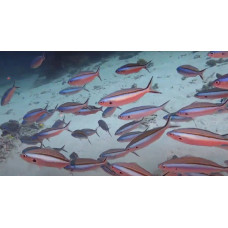Latin name
Pterocaesio tile
Other names
Dark-banded fusilier, blue-streak fusilier, bluedash fusilier, neon fusilier.
Identification
Body elongated, spindle-shaped, somewhat compressed laterally. Two postmaxillary processes. Mouth small, terminal, retractable. Small conical teeth on both jaws, scopa and mouth palate. There are 69-76 scales on the lateral line.
Features of fish fins
The dorsal fin has 11-13 (rarely 10) barb rays and 19-22 soft rays. The anal fin has 3 barb rays and 13 soft rays. The dorsal and anal fins are covered with scales. The barbed portion of the dorsal fin is covered with scales for half of its greatest height. Pectoral fins have 22-24 soft rays. The caudal fin is bifurcated.
Fish colouring
Scales above the lateral line with a bluish-green center and black edges, giving the appearance of a checkerboard pattern. Along the lateral line is a black stripe one row of scales wide (on the caudal trunk this stripe is above the lateral line). Below the black stripe is a shiny light blue zone, usually occupying the middle third of the body, but sometimes the zone is confined to the anterior part of the body, and sometimes it is absent. The lower part of the body is white and pinkish. The pectoral, pelvic, and anal fins are white to pinkish. The sinus and upper part of the base of the pectoral fins are black. Dorsal fin is pale bluish-green to pinkish. Each caudal fin blade has a black stripe; the upper stripe extends to the lateral stripe.
Distribution
Widespread in tropical and subtropical Indo-Pacific waters from the east coast of Africa and Mauritius (absent from the Persian Gulf and Red Sea) to the Tuamotus; north to southern Japan and south to Australia.
Habitat
Marine pelagic fish. They live near coral reefs at depths from one to 60 meters.
Behavior
Forms large aggregations, often with other species of Caesionidae. Do not migrate. Juveniles sometimes appear in large numbers in shallow lagoons and reef shoals.
Food and feeding habits
Feeds on zooplankton in the water column.
Size
Maximum body length 30 centimeters, usually up to 21 centimeters.
Reproduction
Egg-laying fish with numerous small pelagic eggs.
Fishing
This species is of commercial interest to fishermen. It is caught with nets.
Relationship with a person
Dark banded fusiliers are not dangerous to humans. They are a food fish.
| Classification | |
| Phylum | Chordata |
| Class | Actinopterygii |
| Squad | Perciformes |
| Family | Caesionidae |
| Genus | Pterocaesio |
| Species | P. tile |
| Features | |
| Conservation status | Least Concern |
| Habitat | Pelagic |
| Life span, years | No information |
| Maximum body weight, kg | No information |
| Maximum length, cm | 30 |
| Sailing speed, m/s | No information |
| Threat to people | Edible |
| Way of eating | Planktonophage |
Dark-banded fusilier
Tags: dark banded fusilier



